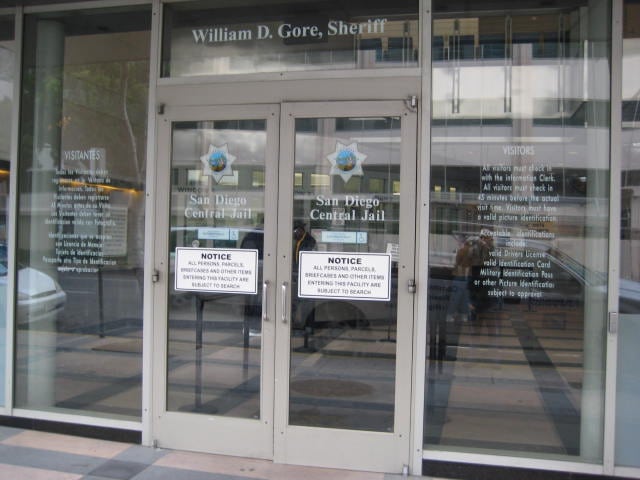You could say that the San Diego County Jail is a place where people are sent to die. Earlier this year, four people tragically lost their lives there within only six weeks. Last year, Disability Rights California, a nonprofit that has been investigating the jail, analyzed 17 prisoner suicides from 2014 to 2016 and found that 15 of the people had not even been convicted of a criminal offense.
Since Sheriff Bill Gore took office in 2009, a staggering 140 people have died behind its bars, due to drug overdoses, suicides, murders and other causes. More than 80 percent of them were awaiting trial. Gore, who faces reelection in 2022, insists that the deaths are not due to management or policy problems. For local residents who follow the news, there is likely a sense of déjà vu: There was already a media series on this crisis six years ago.
To shore up his defense, the sheriff recently paid a San Diego State University statistician, Professor Colleen Kelly, an undisclosed amount of public money to conduct an analysis of the jail’s suicides. Kelly decided that the Average Daily Population (ADP) rate used by federal custody death analysts is unfair to Sheriff Gore—citing everything from high turnover of prisoners in jails to a greater percentage of white people, who have higher overall suicide rates than Black or Latinx people, in San Diego County custody compared to other large California counties.
“Because Caucasians, African Americans and Hispanics have drastically different suicide rates, the racial distribution of each jail system should be accounted for in the comparison,” Professor Kelly wrote.
Furthermore, her report suggests that the number of people who cycle through the jail on a given year should be used to calculate a rate, not the average daily population.
While Kelly’s report may be accurate on a statistical level, there are serious issues with what it presents and what it omits—whether the parameters were set by Gore or by Kelly herself. (It should be noted that Kelly is also consulting as an expert for the county in three lawsuits against the county over prisoners’ deaths.)
First, there is danger that the the statistically higher vulnerability of white people to suicide in a carceral environment can easily lead—through the conflation of correlation with causation—to the idea that they are naturally more prone. At worst, such racial essentialism “carries potentially insidious implications for the care and management of different ethnic groups in prison,” such as the idea that white people deserve better care because Black people are more hardened by their aggregate quality of life as free Americans.
Even by Kelly’s constrained analysis, the San Diego County jail still has a higher suicide rate than all of California’s most populous counties besides Alameda County.
Through its omissions, the report could also be seen to implicitly exonerate those who manage the jail, by not addressing how Gore and his deputies can take steps that lessen the obviously-present suicide risks.
The report’s focus lets additional actors in the criminal legal system off the hook, too. San Diego County has a shorter average jail stay than Los Angeles County, as Kelly notes. Shorter jail stays tend to be associated with sentences of days or weeks for repeated misdemeanors, like disorderly conduct. Yet this narrow focus on length of jail stays omits the fact that San Diego County actually has fewer misdemeanor charges per capita than Los Angeles County, according to reports from the Judicial Council of California—which suggests a systemic issue causing misdemeanor charges to be more likely to result in jail time in San Diego County.
Even by Kelly’s constrained analysis, the San Diego County jail still has a higher suicide rate than all of California’s most populous counties besides Alameda County.
Meanwhile, Gore’s take on the deaths is that being a sheriff is very hard. He told the Citizens Law Enforcement Review Board about difficulties “identifying that potentially suicidal person and getting him in the proper housing.”
What went unsaid is that “proper housing,” according to standard US protocol, is solitary confinement—which most international experts consider a form of torture.
Sheriffs’ elections tend to be sleepy affairs, even though they are largely determinative on issues like medication-assisted treatment access in jails, cooperation with Immigration and Customs Enforcement (ICE) during the Trump regime, and more.
Dave Myers, a gay law enforcement veteran, ran against Gore in 2018 as a progressive who wanted to decriminalize crimes that result from homelessness. San Diego County’s municipalities aggressively try to use criminalization as the solution, even as the total number of homeless people in the county continues to skyrocket. (The county is currently in fourth place in the nation for total number of homeless residents.)
Gore, a Republican in the nonpartisan race, managed to take 55.2 percent of the vote. The local Democratic Party slammed Governor Jerry Brown, himself a supposedly progressive Democrat, for endorsing Gore—in a move that showed how uniquely powerful incumbency is in law enforcement races.
Correction, September 25: An earlier version of this article stated that the four deaths in San Diego County Jail in the space of six weeks earlier this year were due to suicide. In fact, not all of them were suicides.
Photo of San Diego County Jail entrance via Flickr/Creative Commons





Show Comments